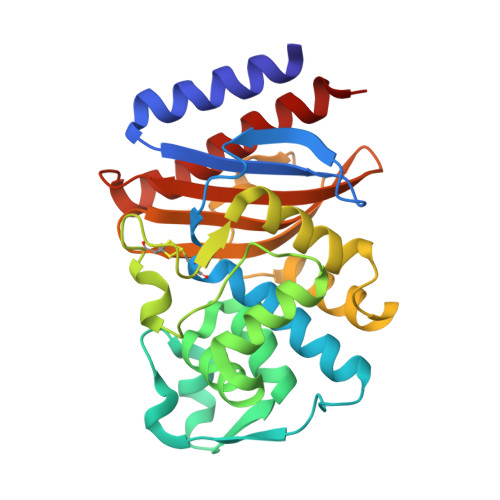Kinetic and structural requirements for carbapenemase activity in GES-type beta-lactamases.
Stewart, N.K., Smith, C.A., Frase, H., Black, D.J., Vakulenko, S.B.(2015) Biochemistry 54: 588-597
- PubMed: 25485972
- DOI: https://doi.org/10.1021/bi501052t
- Primary Citation of Related Structures:
3NI9, 4QU3 - PubMed Abstract:
Carbapenems are the last resort antibiotics for treatment of life-threatening infections. The GES β-lactamases are important contributors to carbapenem resistance in clinical bacterial pathogens. A single amino acid difference at position 170 of the GES-1, GES-2, and GES-5 enzymes is responsible for the expansion of their substrate profile to include carbapenem antibiotics. This highlights the increasing need to understand the mechanisms by which the GES β-lactamases function to aid in development of novel therapeutics. We demonstrate that the catalytic efficiency of the enzymes with carbapenems meropenem, ertapenem, and doripenem progressively increases (100-fold) from GES-1 to -5, mainly due to an increase in the rate of acylation. The data reveal that while acylation is rate limiting for GES-1 and GES-2 for all three carbapenems, acylation and deacylation are indistinguishable for GES-5. The ertapenem-GES-2 crystal structure shows that only the core structure of the antibiotic interacts with the active site of the GES-2 β-lactamase. The identical core structures of ertapenem, doripenem, and meropenem are likely responsible for the observed similarities in the kinetics with these carbapenems. The lack of a methyl group in the core structure of imipenem may provide a structural rationale for the increase in turnover of this carbapenem by the GES β-lactamases. Our data also show that in GES-2 an extensive hydrogen-bonding network between the acyl-enzyme complex and the active site water attenuates activation of this water molecule, which results in poor deacylation by this enzyme.
Organizational Affiliation:
Department of Chemistry and Biochemistry, University of Notre Dame , Notre Dame, Indiana 46556, United States.















